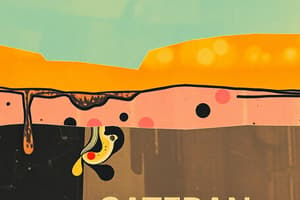Podcast
Questions and Answers
What is the primary composition of spongy bone tissue?
What is the primary composition of spongy bone tissue?
- Trabeculae and open spaces (correct)
- Dense tissue and calcium deposits
- Compact bone and marrow cavities
- Cartilage and collagen fibers
Which characteristic distinguishes compact bone from spongy bone?
Which characteristic distinguishes compact bone from spongy bone?
- Compact bone provides multidirectional support
- Compact bone is lighter and less dense
- Compact bone contains red bone marrow
- Compact bone has a higher capacity for calcium storage (correct)
How do bones receive nourishment?
How do bones receive nourishment?
- From nutrient foramina and small openings (correct)
- Through cartilage diffusion
- By absorption through the periosteum alone
- Directly from the marrow cavities only
What is the role of cartilage in the joints?
What is the role of cartilage in the joints?
What happens at the epiphyseal plate during bone growth?
What happens at the epiphyseal plate during bone growth?
Which bones form the pectoral girdle?
Which bones form the pectoral girdle?
How do the pelvic girdle and vertebral column relate?
How do the pelvic girdle and vertebral column relate?
What is one of the essential functions of compact bone?
What is one of the essential functions of compact bone?
What is the primary function of glial cells in the nervous system?
What is the primary function of glial cells in the nervous system?
Which of the following accurately describes the function of the autonomic nervous system?
Which of the following accurately describes the function of the autonomic nervous system?
From where do sensory axons in the dorsal root of a spinal nerve originate?
From where do sensory axons in the dorsal root of a spinal nerve originate?
What type of stimuli do Meissner corpuscles primarily respond to?
What type of stimuli do Meissner corpuscles primarily respond to?
What substance insulates axons and speeds up action potential transmission?
What substance insulates axons and speeds up action potential transmission?
Which of the following plexuses is not part of the spinal nerves?
Which of the following plexuses is not part of the spinal nerves?
Which structure is responsible for controlling voluntary actions and conscious activities?
Which structure is responsible for controlling voluntary actions and conscious activities?
Which receptors are responsible for sensing pressure in the skin?
Which receptors are responsible for sensing pressure in the skin?
What is the primary function of the fibula in the leg?
What is the primary function of the fibula in the leg?
What type of joint is characterized by bones connected by dense fibrous connective tissue?
What type of joint is characterized by bones connected by dense fibrous connective tissue?
Which classification of joints allows for a wide range of movement and features a fluid-filled cavity?
Which classification of joints allows for a wide range of movement and features a fluid-filled cavity?
Which type of joint allows for some movement but is not fully movable?
Which type of joint allows for some movement but is not fully movable?
What structure connects the tarsal bones to the metatarsal bones in the foot?
What structure connects the tarsal bones to the metatarsal bones in the foot?
Which of the following describes the main characteristic of cartilaginous joints?
Which of the following describes the main characteristic of cartilaginous joints?
How many phalanges does the big toe contain?
How many phalanges does the big toe contain?
Which joint is an example of a synovial joint that allows movement in a full circle?
Which joint is an example of a synovial joint that allows movement in a full circle?
What primarily determines the color of blood?
What primarily determines the color of blood?
What is the primary composition of blood plasma?
What is the primary composition of blood plasma?
Which protein is the most abundant in blood plasma?
Which protein is the most abundant in blood plasma?
What shape do erythrocytes (red blood cells) have?
What shape do erythrocytes (red blood cells) have?
Which component of hemoglobin is essential for binding oxygen?
Which component of hemoglobin is essential for binding oxygen?
What is the average diameter of an erythrocyte?
What is the average diameter of an erythrocyte?
What is the primary function of erythrocytes?
What is the primary function of erythrocytes?
Where are erythrocytes primarily produced in the body?
Where are erythrocytes primarily produced in the body?
What is NOT one of the organs located in the area between the lungs?
What is NOT one of the organs located in the area between the lungs?
Which layer of the heart is responsible for the actual contraction of the heart?
Which layer of the heart is responsible for the actual contraction of the heart?
What is the function of the pericardium?
What is the function of the pericardium?
How many chambers does the heart have?
How many chambers does the heart have?
Which valve prevents blood from flowing backward from the right ventricle?
Which valve prevents blood from flowing backward from the right ventricle?
What role do papillary muscles play in heart function?
What role do papillary muscles play in heart function?
In pulmonary circulation, where does deoxygenated blood go?
In pulmonary circulation, where does deoxygenated blood go?
Which layer of the heart contains small nerves that send electrical signals through the heart?
Which layer of the heart contains small nerves that send electrical signals through the heart?
What occurs during atrial systole?
What occurs during atrial systole?
What does the first heart sound (S1) indicate?
What does the first heart sound (S1) indicate?
Which equation is used to calculate cardiac output?
Which equation is used to calculate cardiac output?
What is the function of the tunica intima in blood vessels?
What is the function of the tunica intima in blood vessels?
Which layer of blood vessels contains elastic fibers and smooth muscle cells?
Which layer of blood vessels contains elastic fibers and smooth muscle cells?
Which statement accurately describes the tunica adventitia?
Which statement accurately describes the tunica adventitia?
During ventricular diastole, what happens in the ventricles?
During ventricular diastole, what happens in the ventricles?
What differentiates capillaries from larger blood vessels?
What differentiates capillaries from larger blood vessels?
Flashcards
Spongy bone structure
Spongy bone structure
Spongy bone is composed of trabeculae and forms the inner part of bones.
Compact bone function
Compact bone function
Compact bone is dense and hard, providing strength and support.
Bone nourishment & innervation
Bone nourishment & innervation
Blood vessels and nerves enter bones through nutrient foramina for nourishment and innervation.
Cartilage function
Cartilage function
Signup and view all the flashcards
Epiphyseal plate growth
Epiphyseal plate growth
Signup and view all the flashcards
Pectoral girdle function
Pectoral girdle function
Signup and view all the flashcards
Pelvic girdle function
Pelvic girdle function
Signup and view all the flashcards
Bone composition
Bone composition
Signup and view all the flashcards
Fibula
Fibula
Signup and view all the flashcards
Tarsal Bones
Tarsal Bones
Signup and view all the flashcards
Metatarsal Bones
Metatarsal Bones
Signup and view all the flashcards
Phalanges
Phalanges
Signup and view all the flashcards
Fibrous Joints
Fibrous Joints
Signup and view all the flashcards
Cartilaginous Joints
Cartilaginous Joints
Signup and view all the flashcards
Synovial Joints
Synovial Joints
Signup and view all the flashcards
Synarthroses
Synarthroses
Signup and view all the flashcards
Peripheral Nervous System (PNS)
Peripheral Nervous System (PNS)
Signup and view all the flashcards
Central Nervous System (CNS)
Central Nervous System (CNS)
Signup and view all the flashcards
Somatic Nervous System
Somatic Nervous System
Signup and view all the flashcards
Autonomic Nervous System
Autonomic Nervous System
Signup and view all the flashcards
Sensory Receptors
Sensory Receptors
Signup and view all the flashcards
Glial Cells
Glial Cells
Signup and view all the flashcards
Myelin
Myelin
Signup and view all the flashcards
Spinal Nerves
Spinal Nerves
Signup and view all the flashcards
Blood Color
Blood Color
Signup and view all the flashcards
Plasma Composition
Plasma Composition
Signup and view all the flashcards
Plasma Proteins: Albumin
Plasma Proteins: Albumin
Signup and view all the flashcards
Plasma Proteins: Globulins
Plasma Proteins: Globulins
Signup and view all the flashcards
Erythrocyte Shape
Erythrocyte Shape
Signup and view all the flashcards
Erythrocyte Size
Erythrocyte Size
Signup and view all the flashcards
Erythrocyte Structure
Erythrocyte Structure
Signup and view all the flashcards
Hemoglobin's Role
Hemoglobin's Role
Signup and view all the flashcards
Atrial Systole
Atrial Systole
Signup and view all the flashcards
Ventricular Systole
Ventricular Systole
Signup and view all the flashcards
Atrial Diastole
Atrial Diastole
Signup and view all the flashcards
Ventricular Diastole
Ventricular Diastole
Signup and view all the flashcards
S1 Heart Sound
S1 Heart Sound
Signup and view all the flashcards
S2 Heart Sound
S2 Heart Sound
Signup and view all the flashcards
Cardiac Output (CO)
Cardiac Output (CO)
Signup and view all the flashcards
Stroke Volume (SV)
Stroke Volume (SV)
Signup and view all the flashcards
Mediastinum Location
Mediastinum Location
Signup and view all the flashcards
Heart Wall Layers
Heart Wall Layers
Signup and view all the flashcards
Pericardium Function
Pericardium Function
Signup and view all the flashcards
Heart Chambers: Atria
Heart Chambers: Atria
Signup and view all the flashcards
Heart Chambers: Ventricles
Heart Chambers: Ventricles
Signup and view all the flashcards
Heart Valves Function
Heart Valves Function
Signup and view all the flashcards
Pulmonary Circulation
Pulmonary Circulation
Signup and view all the flashcards
Systemic Circulation
Systemic Circulation
Signup and view all the flashcards
Study Notes
Levels of Organization
- Molecules are the chemical level, composed of atoms, ions, and small molecules
- Cells are the basic unit of life and the smallest unit capable of reproduction
- Tissues are groups of similar cells that work together to perform specific functions
- Organs are structures formed by two or more tissues working together for a specific function
- Organ systems are groups of organs working together
- Organism is the complete human organism
Homeostasis
- Homeostasis is the process by which living organisms maintain a stable internal environment, even when external conditions change.
- This process allows the body to function properly and survive.
Negative Feedback Loops
- Negative feedback loops counteract changes to internal variables to maintain homeostasis.
- The feedback loop acts against a stimulus to bring it back to its set point.
Anatomical Position and Body Planes
- Anatomical position is the standard descriptive position of the body.
- Body planes are imaginary planes that pass through the body in the anatomical position. Coronal (frontal) plane, Sagittal (longitudinal) plane, Transverse (axial) plane.
- Directional terms include: medial, lateral, ventral, dorsal, distal, proximal.
Intracellular and Extracellular Fluid
- Intracellular fluid is the fluid inside cells.
- Extracellular fluid is the fluid outside cells.
- Extracellular fluid is subdivided into plasma, interstitial fluid, and transcellular fluid.
Passive and Active Transport
- Active transport uses energy to move molecules from a lower concentration to a higher concentration.
- Passive transport moves molecules from a higher concentration to a lower concentration without using energy.
Cellular Processes (Replication, Transcription, Translation)
- DNA replication creates identical DNA strands.
- Transcription converts DNA into mRNA.
- Translation decodes mRNA into amino acids, forming proteins.
Integumentary System - Epithelial Tissue Function
- Protection, secretion, absorption, sensation, and glandular functions are performed by epithelial tissue.
- Epithelial tissue lines body cavities and hollow organs and covers all internal and external surfaces of the body.
Studying That Suits You
Use AI to generate personalized quizzes and flashcards to suit your learning preferences.




